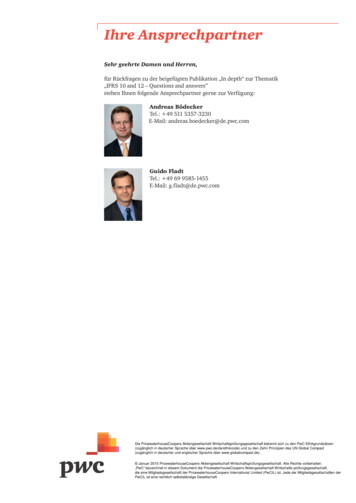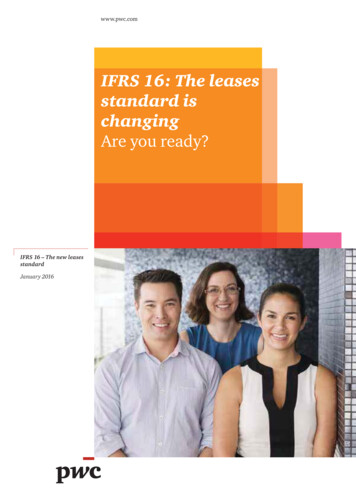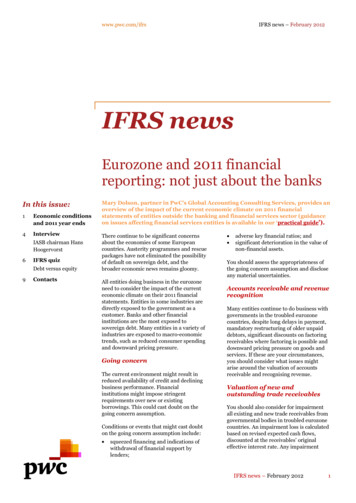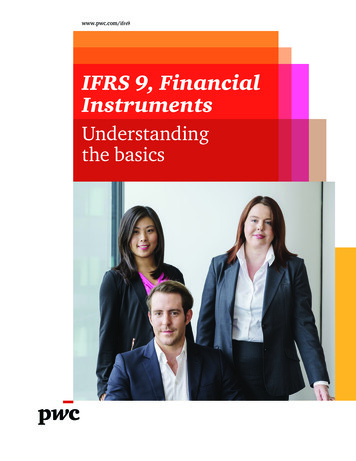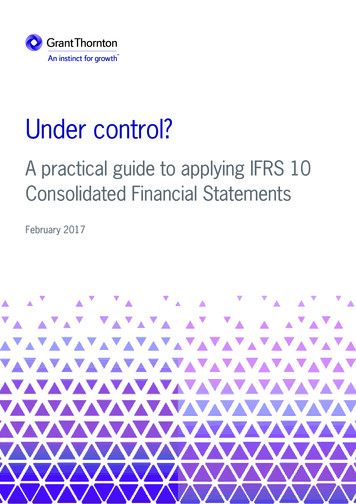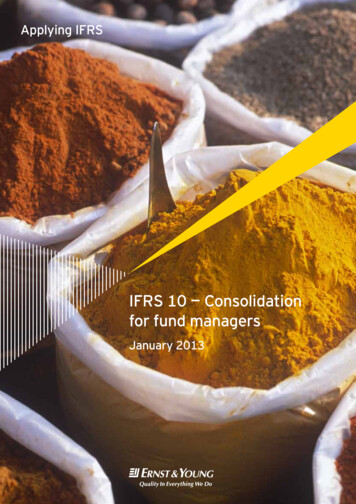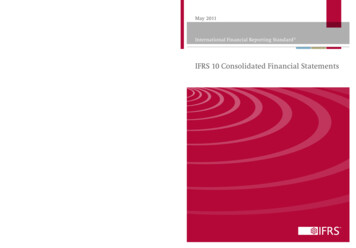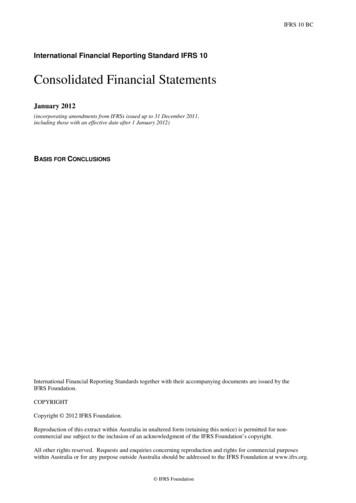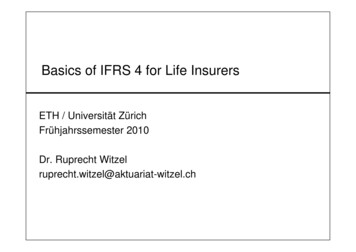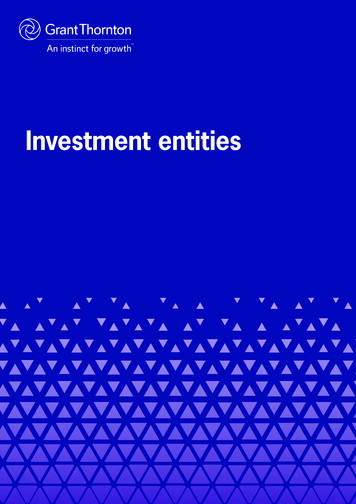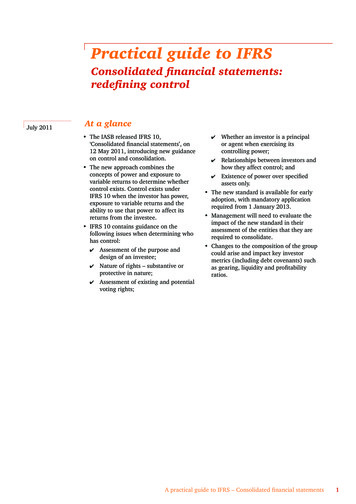
Transcription
Practical guide to IFRSConsolidated financial statements:redefining controlJuly 2011At a glance The IASB released IFRS 10,‘Consolidated financial statements’, on12 May 2011, introducing new guidanceon control and consolidation. The new approach combines theconcepts of power and exposure tovariable returns to determine whethercontrol exists. Control exists underIFRS 10 when the investor has power,exposure to variable returns and theability to use that power to affect itsreturns from the investee. IFRS 10 contains guidance on thefollowing issues when determining whohas control:4 Assessment of the purpose anddesign of an investee;4 Nature of rights – substantive orprotective in nature;4 Assessment of existing and potentialvoting rights;Whether an investor is a principalor agent when exercising itscontrolling power;4 Relationships between investors andhow they affect control; and4 Existence of power over specifiedassets only. The new standard is available for earlyadoption, with mandatory applicationrequired from 1 January 2013. Management will need to evaluate theimpact of the new standard in theirassessment of the entities that they arerequired to consolidate. Changes to the composition of the groupcould arise and impact key investormetrics (including debt covenants) suchas gearing, liquidity and profitabilityratios.4A practical guide to IFRS – Consolidated financial statements1
ContentsAt a glanceIntroductionScopeControlFramework for assessment of controlPurpose and design of the investeePowerRelevant activitiesPower over relevant activitiesSubstantive or protective rightsVoting and potential voting rightsStructured entitiesVariable returnsLink between power and returns – principal vs agentOther issuesDe facto agentSilosFrequency of reassessmentAccounting requirementsDisclosuresGeneral objective of IFRS 12Scope of disclosuresAggregation of disclosuresSignificant judgements and assumptionsTransitionPotential business impactsIndustry insightsWhere to go for more informationAppendix A: Disclosure checklist2PwC – A practical guide to new IFRSs for 333334
Introduction1. IFRS 10 is the major output of theconsolidation project, resulting ina single definition of control for allentities. The IASB continues work ona project that will propose changes tohow investment entities account forentities they control. An exposure drafton investment entities is expected inthe third quarter of 2011. A separatestandard, IFRS 12 ‘Disclosure of interestsin other entities’, sets out disclosures forinvestor/investee relationships.PwC observation: The consolidationproject has been on the IASB’s agendasince June 2003. The objective was todevelop a standard to replace IAS 27 andSIC 12. IFRS 10 revises the definition ofcontrol and provides detailed applicationguidance so that a single control modelcan be applied to all entities. Theproject was developed partly to addressperceived inconsistencies betweenIAS 27 and SIC 12, and also to enhanceconvergence with US GAAP. The projectwas accelerated in 2008 as a result of theglobal financial crisis.2. The key principle in the new standard isthat control exists, and consolidation isrequired, only if the investor possessespower over the investee, has exposureto variable returns from its involvementwith the investee and has the ability touse its power over the investee to affectits returns.PwC observation: The new standard willaffect some entities more than others. Theconsolidation conclusion is not expectedto change for most straightforwardentities. However, changes can resultin complex cases. Entities that are mostlikely to be affected potentially includeinvestors in the following entities: entities with a dominant investorthat does not possess a majority votinginterest, where the remaining votes areheld by widely-dispersed shareholders(de facto control); structured entities; entities that issue or hold significantpotential voting rights; and asset management entities.In difficult cases, the precise facts andcircumstances will affect the analysisunder IFRS 10. IFRS 10 does not provide‘bright lines’ and requires consideration ofmany factors.3. The new standard also sets outconsolidation principles and guidancefor measuring non-controlling interests,potential voting rights and accountingfor loss of control.Scope4. IFRS 10 applies to all parent entitiesthat need to present consolidatedfinancial statements, except for postemployment benefit plans or other longterm employee benefit plans to whichIAS 19 applies (IFRS 10.4b).5. Parent entities are exempted from havingto consolidate if:(a) the parent is a wholly or partiallyowned subsidiary in which all ownersdo not object to non-consolidation;(b) the parent’s debt or equity securitiesare not publicly traded;(c) the parent did not file, and is notfiling, its financial statements to issuepublicly-traded instruments; and(d) the ultimate or any intermediateparent of the parent entity producesIFRS consolidated financialstatements that are available forpublic use.(IFRS 10.3)PwC observation: The exemptionsfrom consolidation and the ‘how-to’ ofconsolidation have not changed fromIAS 27.A practical guide to IFRS – Consolidated financial statements3
ControlControlAbility to use power toaffect returnsPowerVariable returnsIllustration 1: The elements of control6. Control exists when an investor has allthree of the following elements:(a) power over the investee;(b) exposure or rights to variablereturns from its involvement withthe investee; and(c) the ability to use its power overthe investee to affect the amount ofthe investor’s returns.(IFRS 10.7)PwC observation: Previously, controlthrough voting rights was addressedby IAS 27, while exposure to variablereturns was an important considerationwithin the SIC 12 framework. However,the relationship between these twoapproaches to control was not alwaysclear. IFRS 10 links power and returnsby introducing an additional requirementthat the investor is capable of wieldingthat power to influence its returns.Framework for assessment of controlAssess purpose and design (para 8-9)Assess power (illustration 3)What activities significantly affect the investee’s returns (‘relevant activities’)?How are decisions about relevant activities made?Do investor’s rights provide ability to direct relevant activities?Assess exposure to variable returns (para 42-44)Assess ability to use power to influence variable returnsPrincipal/agent assessment (illustration 20)De facto agent assessment (para 49-51)Illustration 2: Framework for assessment of control7. Reassessment of control is required if facts and circumstances indicate that any of theelements have changed (IFRS 10.8).4A practical guide to IFRS – Consolidated financial statements
Purpose and design ofthe investee8. The purpose and design of an investeecould impact the assessment of whatthe relevant activities are, how thoseactivities are decided, who can directthose activities, and who can receivereturns from those activities(IFRS 10.B5). The consideration ofpurpose and design may make it clearthat the entity is controlled by votingor potential voting rights (IFRS 10.B6).9. Voting rights in some cases may notsignificantly impact an investee’sreturn. The investee may be on‘auto-pilot’ through contractualarrangements. In those cases, thefollowing should be considered inassessing the purpose and design of anentity (IFRS 10.B8):(a) downside risks and upsidepotential that the investeewas designed to create;(b) downside risks and upsidepotential that investee wasdesigned to pass on to otherparties in the transaction; and(c) whether the investor is exposedto those risks and upside potential.PowerControlPowerAbility to use power toaffect returnsVariable returns10. An investor has power over aninvestee when the investor has existingsubstantive rights that giveit the current ability to direct therelevant activities (IFRS 10.10,IFRS 10.B9). Relevant activities arethe activities that significantly affectthe investee’s returns.The diagram below summarisesthe considerations involved in theassessment of power.Determine relevant activities(paras 12-13, illustration 4b)Assess purpose and designof entity (para 8-9)Determine how relevant activities are directed (paras 14-15)Determine whether investor’s rights provide abilityto direct relevant activitiesDoes entity own 50% of substantive*voting rights (illustration 9)?NoDirected byvoting rightsIs there de facto control(illustration 10)?Directed bycontractsDoes entityhave power overstructured entity(illustration 18)?NoNo powerNoYesYesPowerDo substantive* potential voting rights givecontrolling power (illustration 14)?NoDo other contractual agreements, orsome combination of contracts, votingrights, and potential voting rights providecontrolling power (para. 27)?UnclearConsider factors inIFRS 10.B18-B20(illustration 6).NoNo powerPowerIllustration 3: Conceptual flowchart for assessment of power* Whether rights are substantive or protective is dealt with in illustration 7.11. IFRS 10 provides the followingadditional guidance in relation tothe determination of control:(a) Where equity instrumentsclearly determine voting rightsand powers to control, themajority shareholder hascontrol in the absence of otherfactors (IFRS 10.B35); and(b) When two or more investorsmust act together to directactivities that affect returns,neither investor has control(IFRS 10.9).A practical guide to IFRS – Consolidated financial statements5
services;(b) management of financial assetsbefore and after default;(c) selection, acquisition and disposalof assets;(d) research and development; and(e) funding activities (IFRS 10.B11).PwC observation: Control isdetermined by voting rights in themajority of cases. No further assessmentis required to determine control.Relevant activities13. Decisions over relevant activitiesmay include operating, capitaland budgetary decisions; or theappointment, remuneration andtermination of service providers or keymanagement (IFRS 10.B12).12. IFRS 10 defines ‘relevant activities’as those activities of the investeethat significantly affect the investee’sreturns (IFRS 10 Appendix A).IFRS 10 offers a wide range of possible‘relevant’ activities including but notlimited to:(a) sales and purchases of goods andThe following examples are summarisedfrom IFRS 10 examples 1 and 2:Example 13.1 Two investors form an investee todevelop and market a medical product. One investor has the responsibilityand the unilateral ability to makeall decisions relating to productdevelopment and to obtainingregulatory approval. Once the regulator has approved theproduct, the other investor has theresponsibility and the unilateralability to make all manufacturingand marketing decisions.RegulatoryapprovalActivity 1:ProductdevelopmentInvestor A decidesActivity 2:Manufacturing/MarketingInvestor B decidesIllustration 4(a): Relevant activities directed by differentparties – example 13.1Which investor has power over the investee?SolutionThe considerations are summarised in the flowchart below:Do both activities significantly affectinvestee’s returns?NoConsider only the activity thatsignificantly affects returns.YesWhich activity most significantly affect returns?General considerations:a) the purpose and design of the investee;b) the factors that determine the profit margin, revenue and value of the investee as well as thevalue of the medical product;c) the effect on the investee’s returns resulting from each investor’s decision-making authoritywith respect to the factors in (b); andd) the investors’ exposure to variability of returns.Considerations specific to this example:e) the uncertainty of, and effort required in, obtaining regulatory approval (considering theinvestor’s record of successfully developing and obtaining regulatory approval of medicalproducts); andf) which investor controls the medical product once the development phase is successful.Illustration 4(b): Relevant activities directed by different parties – example 13.16A practical guide to IFRS – Consolidated financial statements
PwC observation: This type of decisionwill be highly judgemental in practice.For example, when one investor isresponsible for manufacturing andanother investor is responsible formarketing, it can be difficult to identifywhich activity has more effect onreturns. The answer could be affectedby the investee’s strategy. For example,consider a low-cost manufacturerof a commoditised product and amanufacturer of a high-end brandedproduct. Low-cost manufacturing couldbe the critical process for the firstmanufacturer, while effective marketingcould be the critical process in the secondmanufacturer.Example 13.2An investment vehicle (the investee) is created with debt and equity instruments.Asset managerOther equity investors30% equityDebt investor70% equityDebtinstrumentInvestee Equity absorbs first losses and receives residual returns Markets debt instrument as having minimal credit risk due to existence of equity Purchases portfolio of financial assets with debt and equity proceeds Returns affected by:– management of asset portfolio– management of defaulted assetsIllustration 5(a): Relevant activities directed by different parties – example 13.2 The asset manager manages allactivities until defaults reach a specifiedthreshold (i.e. when the equity trancheof the investee has been consumed). Thereafter, a third-party trusteemanages the assets according to theinstructions of the debt investor.The sequence of decision powers are illustrated diagrammatically as follows:DefaultpassesthresholdActivity 1:Asset portfoliomanagementAsset manager decidesActivity 2:Defaulted assetmanagementDebt investor decidesIllustration 5(b): Relevant activities directed by different parties – example 13.2Who controls the investment vehicle?SolutionThe asset manager and the debt investor each need to determine whether theyare able to direct the activities that most si
4. IFRS 10 applies to all parent entities that need to present consolidated financial statements, except for post-employment benefit plans or other long-term employee benefit plans to which IAS 19 applies (IFRS 10.4b). 5. Parent entities are exempted from having to consolidate if: (a) the parent is a wholly or partially- owned subsidiary in which all owners
